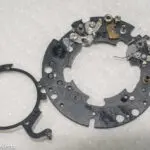This post is an index of camera types which have been produced over the last hundred or so years. It will be added to as I get time and as I acquire new examples of the different types in my collection.
The first group of camera types are generally considered film cameras, and they are followed by some digital camera types.
Viewfinder camera types
The viewfinder camera, of the type show to the left, is a basic camera which was normally sold as a snapshot camera and is one of the simplest camera types.
The actual name 'viewfinder camera' just refers to the fact that the way the final image is composed is through an optical viewfinder, but it generally tends to mean a lower spec camera.
Although it is perfectly possible to get good quality pictures from this type of camera, there are some basic technical reasons why they would not be good for all circumstances. Because of the space between the viewfinder and the lens, the image you see is a distance away from the actual image the camera takes resulting in parallax error. This results in photos taken with viewfinder cameras often suffering from problems with subject's heads being cut off at the top of the frame.
There have been many viewfinder cameras made over the major years of film camera manufacture ranging from quite good units, like the Zeiss Ikon pictured here to simple Instamatic units which were not so good.
Rangefinder Camera types

The rangefinder camera design is one which is similar to the viewfinder camera above, but with a built-in focus aid called a rangefinder.
The rangefinder works on the principle of viewing the scene from two different positions to produce two views which are superimposed in the viewfinder. This can be seen in the picture of the Fed 3 to the right. The square viewfinder produces the normal view of the scene, and then another view is produced by the small circular window to the left of the lens. The image from this view is projected by a mirror to appear in the centre of the normal viewfinder and is coloured with a filter to distinguish it from the normal view.
The mirror is moved via a control and when the two views are exactly superimposed a scale can be read which will show the distance to the subject. Sometimes, the control which moves the mirror is also the control which adjusts the focus ring on the lens and so instead of reading a scale the camera is automatically focused when the images superimpose.
Rangefinder cameras were a very popular design and advocates maintained that they were the fastest, and most accurate focusing system produced. Personally, I find the system quicker to use than the other popular design, the SLR, but that is probably because my eyesight is no longer up to focusing quickly 'by eye'.
Sophisticated versions of rangefinder cameras allowed different lenses to be fitted to the camera body to allow more flexibility for the photographer.
Single Lens Reflex

The single lens reflex camera became the dominant camera design of the last 70 to 80 years and is still a major player in digital camera design.
In this design, a mirror is used to deflect the light from the main camera lens up to the viewfinder so that the user sees the same image that will be recorded on the film. The mirror is pivoted on the top axis, so the moment the shutter is pressed it flips up, out of the light path and allows the image to be recorded on the film.
The advantages of this system are that the photographer sees exactly the same image that the film will record which aids composition, and also allows features like depth of field to be judged as well. Modern invocations (well, since the 1960s actually) of this design allow the light level of the scene to be recorded with TTL (through the lens) light meters.
As with the rangefinder camera, most SLR cameras allowed the lens unit to be exchanged for different focal length units, but unlike the rangefinder, the photographer could see the effect of the new lens in the viewfinder.
Folding or Bellows Cameras types

Folding cameras were a way for manufacturers to make their camera smaller than they would otherwise need to be to allow the focal length of the lens being used.
In a folding camera, typically the lens and shutter are mounted on a flexible set of bellows, which can be 'folded' into the camera when it is not being used. When needed, a single button press can expand the bellows and make the camera ready for use again.
Another variant of the folding camera design is the 'tube' version, where the lens is mounted on a solid tube which can be extended by the photographer either manually like on the Braun Paxina, or with a pop out action using a button.
The folding camera is a design which does not preclude the camera also being a viewfinder camera or a rangefinder. There are plenty of examples of folder cameras which are either of this type - for example, the Agfa Karat IV is a folder and a rangefinder.
Twin Lens Reflex camera

The TLR or Twin Lens Reflex is a camera which has two lenses, one for focusing the camera and one for taking the picture.
The two lenses are mounted on the same front panel so they can be moved together. The image from the top lens is reflected up to a focus screen using a mirror, and the image from the bottom lens is set to fall on the film surface. The two lenses are made to be optically identical, but the top lens is not fitted with an aperture or shutter assembly, so the image from this lens is always visible on the focusing screen.
Because the two lenses move together, as the front standard is moved in and out using the focus knob, it's possible to focus the image which will fall on the film using the image shown on the viewing screen.
Although the TLR has some of the advantages of the SLR, there are disadvantages as well. It's not possible to judge the depth of field because the top lens doesn't have an aperture and the camera suffers from parallax errors for close up work. Also, focusing the image is harder in bright sunlight because of the light falling on the image (although the focusing screens do have a protective shade).
Point and Shoot compact camera type
The point and shoot camera has been popular for many years and in many ways covers a variety of other camera types.

For example, it's possible for a Single Lens Reflex camera to have an 'auto everything' mode, which could be thought of turning the camera into a 'point and shoot' unit. Another example could be a modern mobile phone digital camera which is normally used in a 'Point and Shoot' fashion.
There is also however a specific type of camera which this description applies to which is a camera which doesn't have manual overrides and can only operate with everything taken care of by the cameras internal mechanical or electronic systems. These cameras were very popular from the 1980s when they were obviously film cameras, right through to the early digital compact cameras.
The main distinguishing feature of the camera type is that it is an auto everything model which takes care of all aspects of the picture taking process from winding the film to setting the exposure and focusing.
Digital Bridge Camera

The Bridge camera type is a digital camera which sits between the Digital SLR camera and the point and shoot 'digital compact' snapshot camera. It can be thought of as a 'bridge' between those two extremes.
A Bridge camera will generally be a bit bigger than the snapshot camera and a bit smaller than a full size SLR but won't have the interchangeable lens option which is typical of the SLR camera.
Often, bridge cameras will be equipped with quite large zoom lenses which attempt to make up for the inability to exchange lenses, although this will typically make the lenses quite slow.
Another characteristic of the bridge camera type is that the sensor tends to be quite small. This will mean the noise levels will be higher than a DSLR and some effects like background de-focus effects will be quite difficult to achieve.
Mirrorless Digital Camera

The mirrorless digital camera is the very latest design which normally included the quality of a Digital Single Lens Reflex, but doesn't include the mirror box and all the mechanical complication that entails.
Because the mirror box is missing, mirrorless cameras are smaller and lighter than DSLR cameras and have become the standard for serious amateur photographers over the last few years.
Digital Compact Camera
The compact digital camera was a very popular camera type from about 2000 to 2010 before the smartphone became the 'camera in your pocket'.

I digital compact camera was typically a small sensor unit with a 3 to 5 times zoom lens which was small enough to sit in your pocket or bag and be available during your normal day to take out and record everyday life.
Generally, in keeping with the 'shoot quickly' design objective, the digital compact camera would have very little in the way of photographic artistic control. They would be automatic exposure, flash etc, so the user didn't need to think about photography at all.






